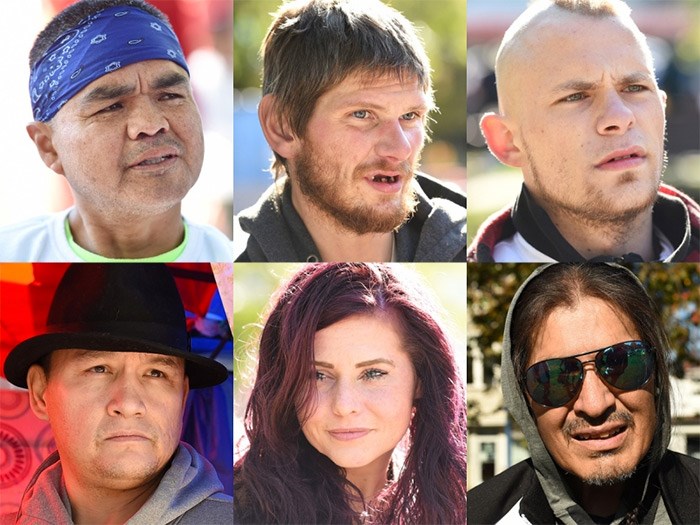 Jacob Stewart, Mike Redpath, Daniel Cameron, Sandy Parisien, Amanda Whitefield and Stanley Stump are among dozens of people living — or who have lived — in Oppenheimer Park. Photos Dan Toulgoet
Jacob Stewart, Mike Redpath, Daniel Cameron, Sandy Parisien, Amanda Whitefield and Stanley Stump are among dozens of people living — or who have lived — in Oppenheimer Park. Photos Dan Toulgoet
The night was cold for Jacob Stewart.
He spent it in a tent in Oppenheimer Park.
He bundled himself in two sleeping bags, which was the best he could do to fight off the cool air blowing through a broken door flap.
“I try to stay positive, even though it’s cold,” he said, sitting in a chair eating a hotdog last Wednesday morning.
How do you do that?
“I just think of work and stuff like that. I think about my family, my daughter. She lives in Chilliwack and she’s going to school and she’s doing really good.”
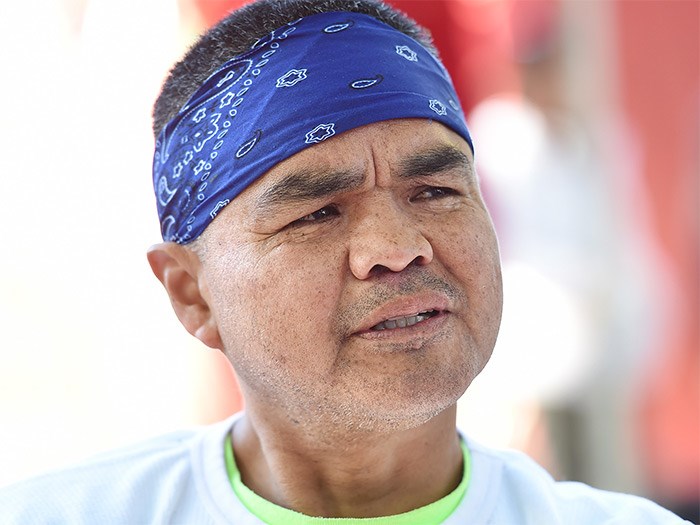 Jacob Stewart, 51, is one of dozens of people living in Oppenheimer Park in the Downtown Eastside. Photo Dan Toulgoet
Jacob Stewart, 51, is one of dozens of people living in Oppenheimer Park in the Downtown Eastside. Photo Dan Toulgoet
Stewart, 51, is one of dozens of homeless people living in the Downtown Eastside park, which is at the centre of a political and community debate that rages on, with no end in sight.
It has now been one year since the first grouping of tents was pitched.
Police Chief Adam Palmer, who has highlighted the increase in police calls to the park related to violence, weapons seizures and gang activity, wants a court injunction to clear Oppenheimer.
Mayor Kennedy Stewart won’t say whether that’s the best path forward. He continues to say he first wants temporary jurisdiction of Oppenheimer from the park board before proceeding with a plan to end the encampment.
That plan may never be implemented.
Last month, a majority of park board commissioners dismissed the mayor’s request, saying they want homelessness, drug addiction, mental illness — all issues linked to poverty — addressed across the city, not just at the park.
The same commissioners rejected park board management’s recommendation to seek an injunction, which was a move commissioners of the day made in 2014 to break up a similar-sized encampment at Oppenheimer.
Meanwhile, the number of campers appears to grow, with more than 100 tents and tarp-based shelters counted Wednesday, including one used for a drug injection site and another big enough to store a car, only it serves as a church.
Estimates on the number of people living in the tents is based on the agency or person doing the math: the city suggests there is approximately 50, with many tents unoccupied or used for storage; the park’s designated “mayor,” Sandy Parisien, put the number at closer to 70 people during the day, and up to 150 at night.
Stewart, a Nisga’a man whose hometown is 60 miles north of Terrace, has lived in the park for two months. He was previously in Edmonton, where he resided in a shelter for eight months, while working in construction.
The last place he paid rent was in Prince George.
He proudly said he hasn’t collected welfare for 15 years and came to Vancouver for work, only to get attacked in a McDonald’s restaurant by someone with a steel pipe. He rubbed his right shoulder as he told his story, saying it has almost healed.
Stewart is in touch with Embers, a job agency in the neighbourhood, about returning to work. Prospects, he said, look good, but he is less optimistic about finding a home.
“Some of my buddies used to live here, and they’ve got homes now,” he said, noting he’s talked to housing outreach workers who visit the park. “I keep bugging them, but nothing yet.”
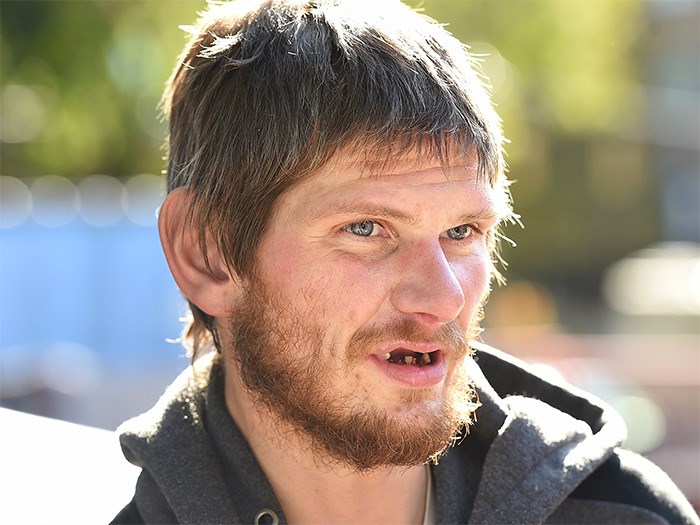 Mike Redpath, 32, used to live in a tent in CRAB park, near the foot of Main Street. Photo Dan Toulgoet
Mike Redpath, 32, used to live in a tent in CRAB park, near the foot of Main Street. Photo Dan Toulgoet
‘Solitary existence’
Standing near the rear doors of the park’s shuttered field house is Mike Redpath, who has been homeless off and on for three years.
Redpath, who believes he’s 32, has lived in the park “intermittently” for six to eight months. He previously pitched a tent for several months in CRAB Park, near the foot of Main Street.
Originally from Fort St. John, where he grew up on a farm, the trained gas fitter last paid rent in Kamloops, where he lived in a townhouse with his girlfriend.
Then, he said, he got into “a bit of an altercation” with the RCMP, which he claimed ended with an officer being charged with assault causing bodily harm.
“I ended up relapsing after that,” said Redpath, who described himself as a recreational drug user until he broke his back in a truck accident near Quesnel almost four years ago.
He developed an addiction to opiates while managing his pain.
Around the same time, his common-law wife died. He was having a tough time financially, mentally and physically, he said, noting he came to Vancouver after a prison stint.
“There’s a little more resources and whatnot to help me be able to get somewhat in a better position in life,” he said, adding that Oppenheimer offers him the closest thing he has to family.
“I found being on the street was a very solitary existence. Half of the people shun you, the other half are scared of you. But no family is perfect, right? There’s a lot of good and a lot of bad here. But it’s no different than any community, really. It’s just a lot more condensed and in your face.”
Redpath stayed on that point, explaining what homelessness does to a person’s mind and spirit.
“The longer you stay alone on the street, the more hostility and resentment you build up,” he said.
“It starts being you against them, whereas once you start being part of the social interaction and the familial interaction on a regular basis, the more you start becoming human and become part of a community again — the more you start doing positive things. It really does seem to make a difference for people.”
He wants housing but his erratic lifestyle has caused him to miss appointments with outreach workers. If he had a home, it would “free up the time to do what I need to do to get moving in the appropriate direction.”
As for reconnecting with family, Redpath wants to first be in a better place mentally and physically.
“I don’t want to make my burden theirs.”
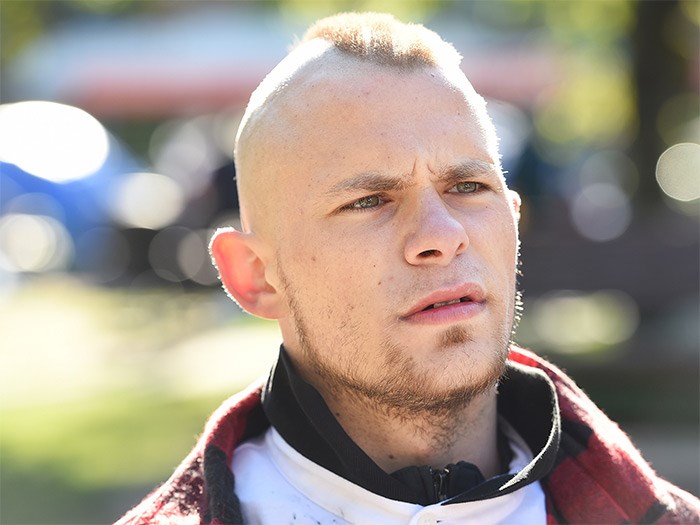 Daniel Cameron, 27, stays on the street or couch surfs when he doesn’t have a tent in the park. Photo Dan Toulgoet
Daniel Cameron, 27, stays on the street or couch surfs when he doesn’t have a tent in the park. Photo Dan Toulgoet
Couch surfing
Daniel Cameron, 27, was in the park Wednesday, a place he has lived off and on for almost a year. He doesn’t have a tent at the moment, saying he stays on the street or couch surfs, which makes it difficult for him to keep any belongings.
“To be honest, what you see on me is what I own,” he said, dressed in layers of clothing and standing on a pathway near the front of the field house.
Born and raised in Surrey, he used to install cedar fences and work at a pawn shop on Saturdays. He now unlocks smart phones and sells clothes and other items he finds in donation bins.
“I try to help people — give them what I find, or sell it for money,” he said.
Six years ago, he was living in a basement suite in Surrey with his girlfriend. She got “sent back” to California, then he got arrested and was in prison for a month.
When he got released, he couldn’t cover the rent and got evicted. His mother lives in Chilliwack. They don’t talk much.
“Once in a while,” he said. “But not as much as we’d like to see each other. It’s a little distant.”
Cameron, Redpath and Stewart all addressed the issues of danger and safety raised by police, firefighters and politicians. Their answers varied but they downplayed the extent of the crime and violence reported in the media.
“If a family were to walk through here, nobody’s going to bother the family,” Cameron said.
“But that family may see something where someone from here is bothering another person from here. You get what I’m saying? If people are going to do something stupid, they’re going to do it to each other.”
704 police calls
At a Sept. 26 park board meeting, deputy police chief Howard Chow and senior officials from city hall and the fire department delivered presentations to commissioners on the state of the park.
Chow told commissioners that officers responded to 704 calls to Oppenheimer between January and August, which was a significant increase over the 383 answered the previous year.
“Nowhere else in the city would you see this, and we’re talking about very serious types of calls — shootings, weapons calls, firearms calls, overdoses, sex assaults,” he said, noting the drug and crime activity historically associated to Main and Hastings has shifted to the park.
Police Chief Adam Palmer told reporters Sept. 19 that gangs were vying for control of the park, and they included the United Nations, Wolfpack and Middle Eastern organized crime.
“There’s a whole host of different people jockeying for position in that park, and it’s dangerous and it’s a concern,” said Palmer, whose officers seized 17 weapons from the park between June and August.
Deputy fire chief Rob Renning told commissioners that firefighters responded to 20 tent fires since August. They also attended 62 medical calls, including six overdoses and 93 miscellaneous calls.
An order is in place to forbid campers to have heaters, propane tanks, fuel, barbecues and candles in tents, but firefighters continue to find the items, including generators, Renning said.
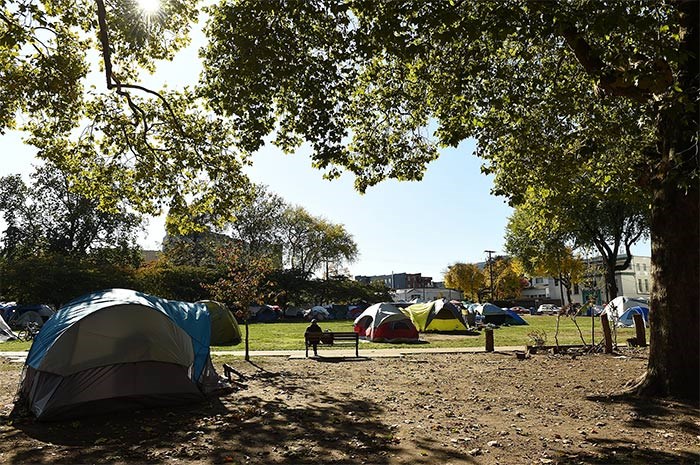 It’s now been one year since the encampment began at Oppenheimer Park, according to the City of Vancouver. Photo Dan Toulgoet
It’s now been one year since the encampment began at Oppenheimer Park, according to the City of Vancouver. Photo Dan Toulgoet
Deputy city manager Paul Mochrie said the tent city began in October 2018 with a small number of people sleeping in the park. That grew to 25 people by February and 137 by August.
Mochrie said staff doesn’t support a “managed encampment” as a response to the city’s homelessness crisis. More than 2,200 people were counted as homeless in the city’s count in March.
“It is not possible for us as a city to manage an uncontrolled site safely and effectively,” he said, noting staff’s focus is on moving people into housing.
He said 130 people accepted housing offers in August. At the time of his presentation, the city was working with another 55 people in an attempt to find them a home.
He pegged the estimated cost to the city of attending to the park, between January and July, at $817,000. That includes costs for the fire department, police, outreach staff, park rangers, janitorial costs and engineering crews, who do weekday clean-ups of the park.
Mochrie said the cost doesn’t include emergency response by police and firefighters. Ambulance costs were not part of the presentations.
He noted the Oppenheimer Park tent city is the fifth significant encampment in Vancouver since the previous take over of the park in 2014.
“We don’t expect it will be the last given the challenges with housing and homelessness we’re facing in the region,” said Mochrie, naming off other encampments over the last three years at 58 West Hastings, 950 Main St. and 1100 Franklin St.
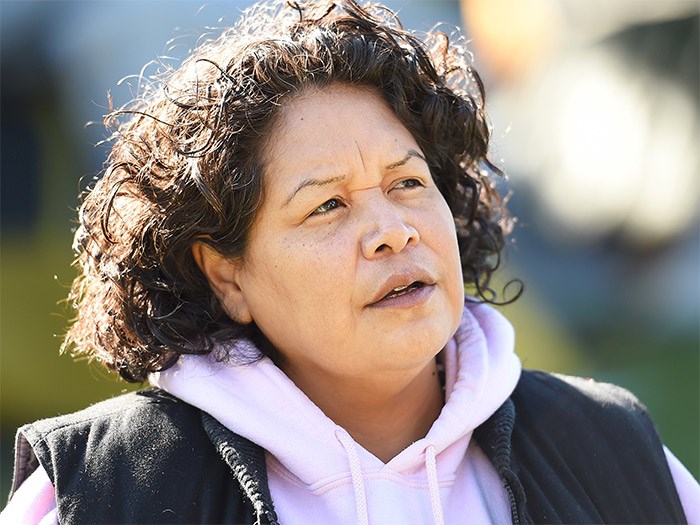 Chrissy Brett, who lives on and off in the park, was involved in the tent city in Victoria. Photo Dan Toulgoet
Chrissy Brett, who lives on and off in the park, was involved in the tent city in Victoria. Photo Dan Toulgoet
Injection site, church on park grounds
Chrissy Brett, who lives off and on at Oppenheimer, attended the same park board meeting.
Like many of the people the Courier spoke to at Oppenheimer, she disputes the police’s framing of the park as dangerous.
“Do you see any gang patches? Do you see any colours being repped here? Do you see any of these things that people are talking about? I don’t, and I’m here every day.”
Added Brett: “I say that Hastings Street and the alleys and camping out alone is way more unsafe and risky than being part of a community.”
What’s not commonly known by the public about the encampment is it has a hierarchy of sorts that was set up by campers, former campers and volunteers such as Brett.
During a tour of the park, Brett explained the park has a “mayor” and a seven-member “community council.” There is a safety committee in place, too, she said.
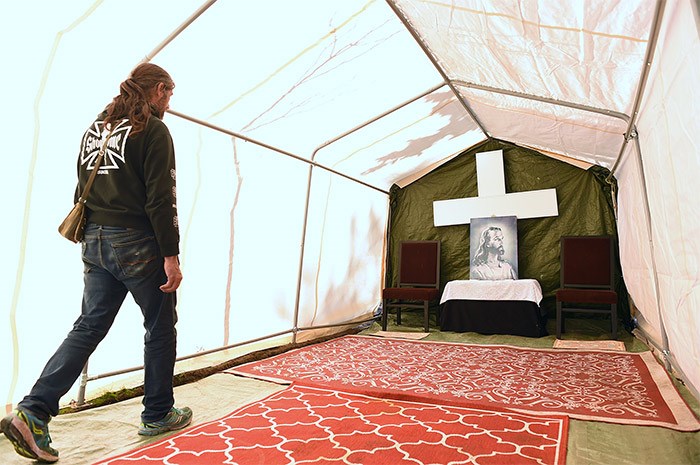 Homeless people at Oppenheimer Park recently built a church on the grounds. Photo Dan Toulgoet
Homeless people at Oppenheimer Park recently built a church on the grounds. Photo Dan Toulgoet
The park also has an injection site set up under a patchwork of tarps at the back of the field house. The “church” was built on the East Cordova Street-side of the park. Inside, it features a large carpet, a picture of Jesus Christ, a crucifix, a makeshift altar and a couple of chairs.
Campers say a pastor from a local church has begun to offer services on Sunday mornings.
Portable toilets have been brought in, various local agencies bring in food — nuns were in the park Wednesday serving hot dogs — and a nearby storefront offers more food and laundry services.
Brett, who serves as a liaison between campers and city officials, said she lives at Oppenheimer during the week and returns home to Victoria on the weekends.
She’s played the same role at tent cities on Vancouver Island.
The Nuxalk grandmother has dedicated her life to speaking out for Indigenous children and adults, working with a child welfare organization and doing court support work and counselling.
As a child adopted out by a Dawson Creek family during the so-called Sixties Scoop, where Indigenous children were taken from their families and communities and given up for adoption or placed in foster homes, Brett is determined to keep families together.
For others, who end up alone and homeless, she is relentless in her pursuit of politicians and city officials to respond to the crisis, having challenged Chow after he left the park board meeting.
She also caused city council to shut down for the night two weeks ago after she refused to end her speech at the three-minute time limit. She was calling into question the state of shelters and single-room-occupancy hotels that former campers now live in.
“Shelters are not homes,” she told council, moments before her microphone was cut off by Coun. Melissa De Genova, who chaired the meeting.
“People deserve basic rights. Housing is a human right, according to the United Nations. Shelters say you only deserve to be human between 6 p.m. and 6 a.m.”
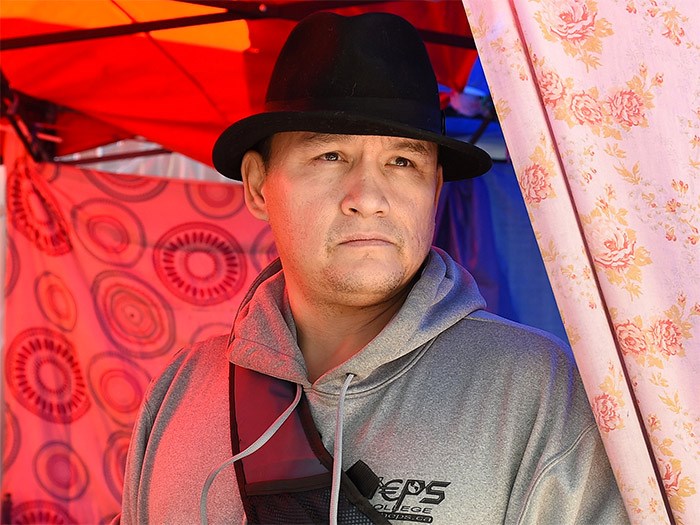 Sandy Parisien, 47, is the “mayor” of the Oppenheimer Park tent city. Photo Dan Toulgoet
Sandy Parisien, 47, is the “mayor” of the Oppenheimer Park tent city. Photo Dan Toulgoet
‘Mayor’ of Oppenheimer
Sandy Parisien is the “mayor” of the park, and he has been in that role since he first pitched a tent more than a year ago when he was part of “the original six” campers.
Outreach teams recently found Parisien housing at a single-room-occupancy hotel on Powell Street, which he described as “disgusting” and “the worst place ever.”
But, he said while standing outside the park’s injection site, he plans to be the last person to leave Oppenheimer, having gained the trust of campers to represent them.
He joined Brett at city hall.
At his turn at the microphone, he suggested the park’s population had increased in size because city crews told homeless people in other parks to pack up their stuff and move to Oppenheimer.
“You caused this problem, not us,” he said, pointing his finger at councillors from the lectern. “You put us together, now we’re a family. We live with each other, we help each other and that’s that.”
The Courier put Parisien’s suggestion to the city’s communications staff, who denied such an order was given to city crews, who routinely collect debris and belongings at parks left behind by people.
Parisien is a member of the Berens River First Nation in Manitoba. As a child, he lived in group homes and children’s care homes, he said, before working his way west.
“It was bad,” he said. “I remember some of it, but not all of it. I just live every day now trying to help everyone else instead of myself. It’s easier to take from the community than it is to give back. I’ve got to give back now.”
Taking from community is a reference to him being “in and out of prison my whole life,” noting he was released from Matsqui Institution about two years ago, but recently picked up a new charge and was given a conditional sentence order.
His sister died in Winnipeg of a drug overdose seven months ago.
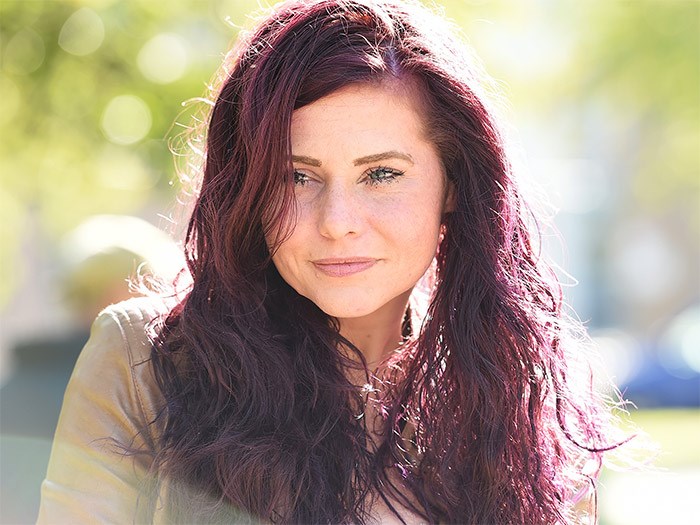 Amanda Whitefield, 32, is originally from Vancouver Island, where she taught yoga. Photo Dan Toulgoet
Amanda Whitefield, 32, is originally from Vancouver Island, where she taught yoga. Photo Dan Toulgoet
Parisien’s fiancée, Amanda Whitefield, was with him Wednesday. She, too, found housing — about a month ago — but keeps a tent in the park, where she emerged with a bowl of cereal.
Originally from Vancouver Island, the 32-year-old said she once lived with a friend in the Tamura building on Dunlevy Avenue that overlooks the park. She got ill and ended up in hospital for six months, she said.
“I lost my place and my daughter while I was in there,” said Whitefield, noting she had a bad infection in her heart.
She came to Vancouver to attend Rhodes Wellness College on Howe Street, where she was working towards a professional counsellor diploma. Previously, she said, she taught yoga to at-risk youth.
She, too, uses the word “family” to describe the people in the park, saying, “We watch out for each other, and I don’t feel any more at risk being here since the day I showed up in the Downtown Eastside four years ago.”
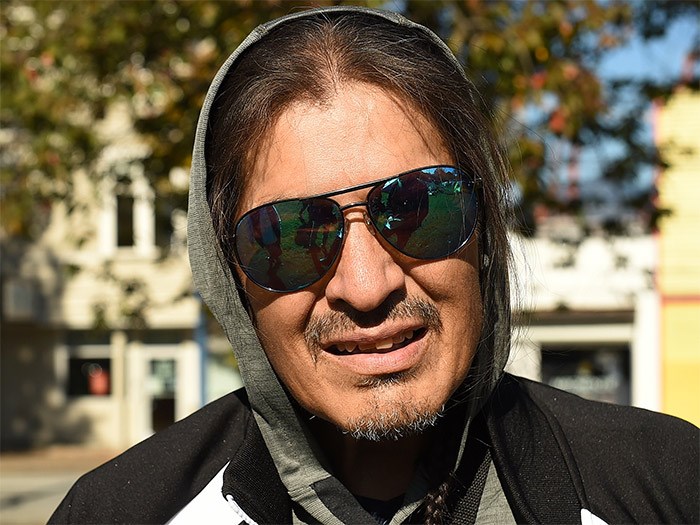 Stanley Stump, 47, is a residential school survivor. Photo Dan Toulgoet
Stanley Stump, 47, is a residential school survivor. Photo Dan Toulgoet
‘Calm within the storm’
What’s striking — but not surprising for people who read the city’s annual homeless count reports — is the overrepresentation of Indigenous peoples living in the park.
“Just like the institutions,” said Stanley Stump, standing outside his tent pitched in the infield of the park’s baseball diamond, where he has lived for about a year.
“We had a jail that could hold 380 guys, and 210 of them were natives.”
Stump, a 47-year-old member of the Anaham Indian Band, spent 15 years of his life in prison.
All of it, he said, points back to the abuse he endured in residential school. He said he and his sister were the only children in his family to go, and the only two to end up with criminal records.
“The abuse was so common that by the time I got to regular school, I had such a high tolerance for pain that I could fight guys who were two grades older than me and win the fight — not by beating them up, but by getting beaten up so much that they’d get tired of beating me up,” he said.
He turned his anger and energy to playing hockey and riding bulls. He named teams he joined in Quesnel and Portland, saying he played what he described as “Indian hockey, where you play as dirty as you can and try not to get caught.”
He pointed out his third cousin on his mom’s side is Montreal Canadiens goaltender, Carey Price, whose hometown is Anahim Lake, B.C. about a three-hour drive west of where Stump lived.
“I played hockey because it was a sport that allowed me to hurt white kids without going to jail,” he said. “I started taking that frame of mind to the street and started using alcohol, and alcohol brought out the rage inside.”
His last five years in prison were served for his involvement in a home invasion — a crime, he said, he wasn’t proud of, but saw his actions as lashing out at the same community that put him in residential school.
“I didn’t look at myself as the problem,” he said, adding that he met a psychologist working in the prison system who counselled him about the trauma he experienced from six years old until he was 10.
“She opened my mind inside out.”
Stump was released from prison last February and ended up at Oppenheimer, first looking after a friend’s tent, then getting his own.
He said he could return to Anaham, but is not in the frame of mind to do so, wanting to work through his own issues and impart some wisdom on the people he sees struggling in the park and on the street.
“For me, this is the calm within the storm,” he said. “It’s like everything around me is dark, but I’ve got the light and I’m trying to shine it on the people who may, or may not want it.”
@Howellings


